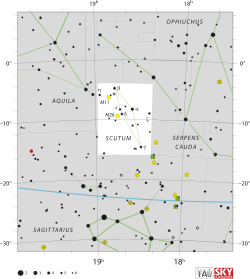Scutum (constellation)
| Constellation | |

|
|
| Abbreviation | Sct |
|---|---|
| Genitive | Scuti |
| Pronunciation |
/ˈskjuːtəm/, genitive /ˈskjuːtaɪ/ |
| Symbolism | the Shield |
| Right ascension | 18.7 |
| Declination | −10 |
| Family | Hercules |
| Quadrant | SQ4 |
| Area | 109 sq. deg. (84th) |
| Main stars | 2 |
|
Bayer/Flamsteed stars |
7 |
| Stars with planets | 1 |
| Stars brighter than 3.00m | 0 |
| Stars within 10.00 pc (32.62 ly) | 0 |
| Brightest star | α Scuti (3.85m) |
| Nearest star |
LHS 3398 (41.54 ly, 12.74 pc) |
| Messier objects | 2 |
| Meteor showers | June Scutids |
| Bordering constellations |
Aquila Sagittarius Serpens Cauda |
|
Visible at latitudes between +80° and −90°. Best visible at 21:00 (9 p.m.) during the month of August. |
|
Scutum is a small constellation introduced in the seventeenth century. Its name is Latin for shield.
Scutum was named in 1684 by Polish astronomer Johannes Hevelius (Jan Heweliusz), who originally named it Scutum Sobiescianum (Shield of Sobieski) to commemorate the victory of the Christian forces led by Polish King John III Sobieski (Jan III Sobieski) in the Battle of Vienna in 1683. Later, the name was shortened to Scutum.
Five bright stars of Scutum (α Sct, β Sct, δ Sct, ε Sct and η Sct) were previously known as 1, 6, 2, 3, and 9 Aquilae respectively.
Coincidentally, the Chinese also associated these stars with battle armor, incorporating them into the larger asterism known as Tien Pien, i.e., the Heavenly Casque (or Helmet).
Scutum is not a bright constellation, with the brightest star, Alpha Scuti, at magnitude 3.85. But some stars are notable in the constellation. Beta Scuti is the second brightest at magnitude 4.22, followed by Delta Scuti at magnitude 4.72. Beta Scuti is a binary system, with the primary with a spectral type similar to the Sun, although it is 1,270 times brighter. Delta Scuti is a bluish white giant star, which is now coming at the direction of the Solar System. Within 1.3 million years it will come as close to 10 light years from Earth, and will be much brighter than Sirius by that time.
UY Scuti is a red supergiant pulsating variable star. At 1,708 ± 192 solar radii, it is the largest star currently known.
Although not a large constellation, Scutum contains several open clusters, as well as a globular cluster and a planetary nebula. The two best known deep sky objects in Scutum are M11 (the Wild Duck Cluster) and the open cluster M26 (NGC 6694). The globular cluster NGC 6712 and the planetary nebula IC 1295 can be found in the eastern part of the constellation, only 24 arcminutes apart.
...
Wikipedia
